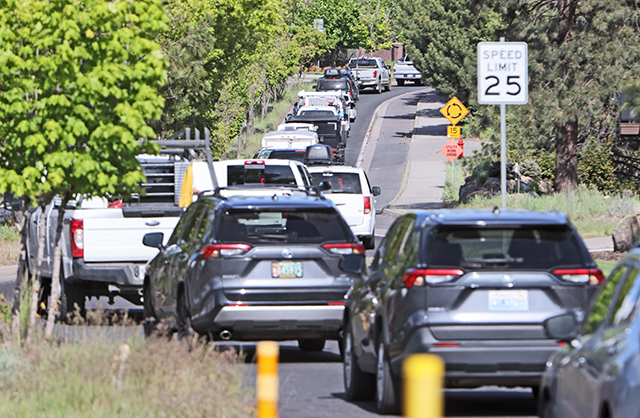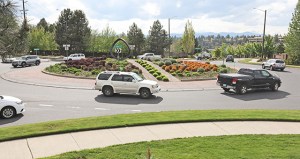Bend neighbors urge faster fix for roundabout bottleneck
Published 5:45 am Saturday, May 24, 2025

- Rush hour traffic heading east on Reed Market Road toward the Bond Street and Brookswood Boulevard roundabout in Bend. 05/19/25 (Dean Guernsey/The Bulletin)
Long lines of crawling cars are a familiar sight for Todd Torczon. He lives next to Reed Market Road, a stone’s throw from Farewell Bend Park and the Deschutes River on the other side. Nearly every afternoon, the cars back up past his house.
The cars are waiting to pass through a roundabout nearly a half mile to the east, at the intersection with Bond Street. Torczon figures if the cars are stagnant outside his house, there must be a line 100 strong. It’s worse during rush hour, he said. He said a few months ago it took him 4 minutes to go 1,000 feet, or 3 miles per hour on average.
Many people find the delays aggravating, he said. But what really makes him shudder is the thought of what would happen if a large wildfire burning west of Bend funneled thousands of fleeing drivers to the corridor.
The city of Bend has a solution planned to alleviate some congestion: widen the roundabout to increase the flow of traffic. But it can’t come soon enough, Torczon said. The project that once appeared to be on track for construction by mid-decade is now penciled in for 2029. So as the city hashes out its budget for the next two years, Torczon is drumming up as much public support as he can for the city to move the roundabout fix to the top of its transportation queue.
One of Bend’s 13 neighborhood groups, the Southern Crossing Neighborhood Association, recently launched a survey to gather public sentiment about the roundabout.
The lobbying effort probes a broader debate over how Bend should deal with growing pains on its transportation system as it looks to make the city more walkable and bikeable while juggling a long list of construction projects. It’s also a reflection of heightened concerns that Bend’s streets would become gridlocked during a wildfire evacuation scenario following devastating wildfires across the country.
Roundabout expansion planned for 2029
Pressurizing the debate are the impacts of ongoing construction projects citywide, as the city races to complete 30-some projects promised by a $190 million bond measure voters approved in 2020.
Funding for the Reed Market-Bond roundabout does not come from that bond measure, but from the transportation construction fund, a mix of grants, fees the city collects from utility companies for using the right-of-way and fees the city collects from developers for impacts to the transportation system.
Under the city’s draft budget, which could be adopted next month, there is $4.25 million earmarked for a Reed Market-Bond roundabout widening project, with design beginning in late 2028 and construction occurring in 2029.
That proposal would push the project back one year from its previous schedule, said Ryan Oster, the city’s lead transportation engineer.
“It just comes down to different priorities, having enough money to complete existing projects, and meeting all the needs of the transportation system,” he said.
Long-standing problem gets worse
Stretching from 27th Street on the east side to Century Drive on the west, Reed Market Road is one of the only straight-shot corridors capable of carrying travelers across major traffic barriers such as the Bend Parkway and the Deschutes River. At the intersection with Bond Street, crosstown drivers converge with those heading from neighborhoods of southwest Bend to the Old Mill District, downtown or anywhere west of the Deschutes.

Rush hour traffic in the roundabout at Reed Market Road and Bond Street in Bend. 05/16/25 (Dean Guernsey/The Bulletin)
In 2020 the city launched a pilot project assessing how adding metered traffic signals at the roundabout entrance might improve capacity. After inconclusive results, the city decided a more heavy-handed approach would be necessary.
Bend’s rampant growth during the COVID-19 pandemic added even more demand on the roundabout. Torczon has noticed the traffic get worse since he started construction on a home in the Wood River Village neighborhood next to the roundabout in 2021. He’s noticed an influx of cars using the quiet residential streets as a cut through.
Oster said there hasn’t been a traffic study there since the metering project, but the intersection is “one of more important intersections in town to fix,” which is why it’s on the project list.
But, Oster said, “It seems like it doesn’t matter where you go … every intersection is backed up significantly more than it was even two or three years ago.”
The city has been working to deliver on its promise of building more than 30 projects funded by the 2020 bond measure with hopes to solidify future voter support for transportation funding. The bond funding is focused on a range of projects from bicycle and pedestrian safety to congestion control.
The Reed Market corridor was also a focus. The bond allocated $32 million between a new railroad overcrossing, another roundabout expansion at the intersection with 15th Street and a Bend Parkway project.
Another planned project improving connections at Brosterhous Road and Chase Road is planned for 2026 and 2027 to help alleviate congestion on Reed Market. It’s the same price as the Reed Market-Bond roundabout project, so Torczon believes the two could be swapped, bumping the roundabout up by two years.
Taking cars off the road
An even better scenario would be to begin design later this year, pointing out that the city plans to spend $10.7 million from the transportation construction fund in the next two years on creating a system of bicycle greenways — low-stress routes through residential areas.
To City Councilor Ariel Méndez, who serves on the lead transportation planning board for the Bend area, the traffic backups at the Reed Market-Bond roundabout and across the city are a symptom of a larger issue: not enough people are walking, biking or taking the bus.
Widening roads, he said, will only result in more traffic in the long run.
“More effective solutions look at how we can remove cars from our streets so that the people who really need to still drive, including emergency response vehicles, can still drive and everyone else can get where they’re going safely and conveniently,” Méndez said.
Torczon said he is not opposed to building bicycle greenways, but not at the expense of wildfire evacuation routes.
“I just don’t get why that’s a higher priority,” Torczon said.
Not the only solution
The gridlock that caused people to flee their cars and evacuate on foot during catastrophic wildfires earlier this year in Southern California painted a grim picture for many residents who foresee the same playing out in Bend. That has prompted new discussions among the city council, Méndez said.
The reality is that Bend’s streets are not designed with wildfire evacuation as the highest priority, Oster said. And widening the Reed Market-Bond roundabout likely won’t significantly cut wildfire evacuation times, he said.
“Wildfire evacuation is a much broader discussion than just expanding one roundabout,” Oster said.
Getting drivers quickly out of harm’s way during a wildfire — and reducing daily congestion — could come down to creating more east to west connections. Part of the reason why the Reed Market-Bond street roundabout is so crowded is because of growth in neighborhoods stretching miles to the southwest. To get anywhere on the west side, those people are funnelled through the Bill Healy Bridge across the Deschutes River on Reed Market Road, which likely won’t be expanded.
As the city grows it will ultimately need to build another bridge crossing the Deschutes south of Reed Market. There is money earmarked to complete a study of such a crossing, but the city hasn’t started it yet.







